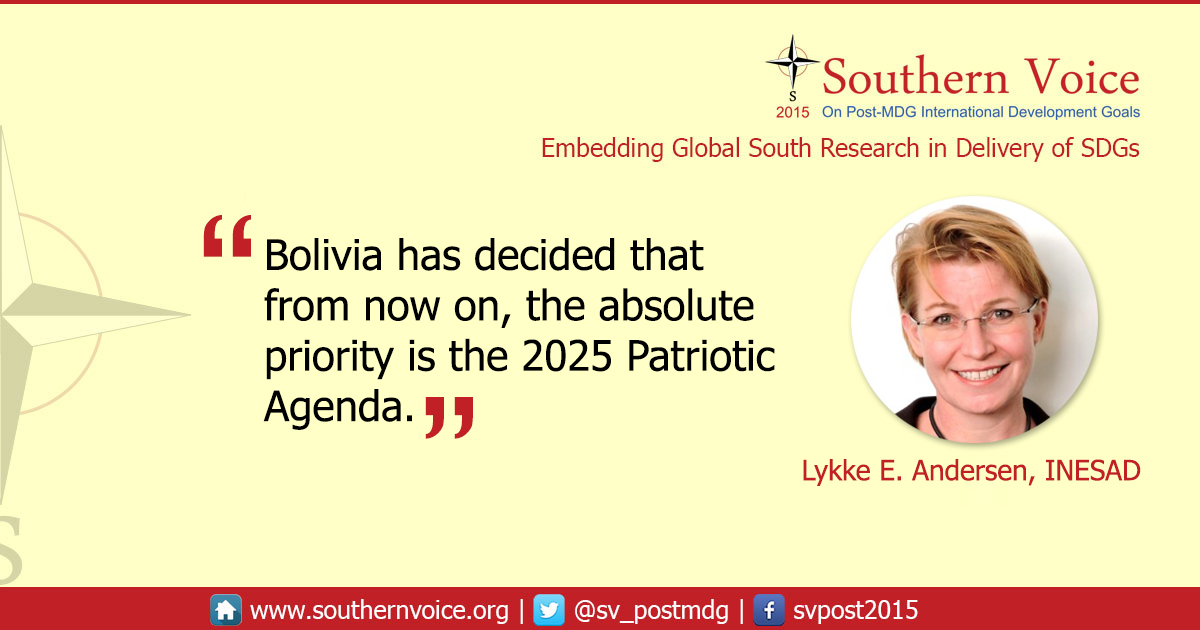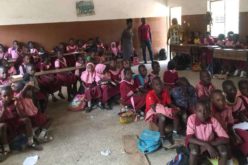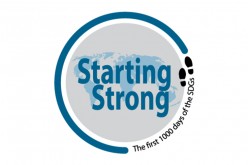Bolivia’s Patriotic Agenda is more ambitious than the SDGs
Southern Voice’s network member Lykke E. Andersen, Director of Research at the Institute for Advanced Development Studies (INESAD) sums up and shares Bolivia’s SDG experiences to date.

Q. What can you tell us about how the SDGs are being adopted in Bolivia’s development plan?
While Bolivia has reported faithfully on the Millennium Development Goals (MDGs) and almost achieved them, Bolivia has decided that from now on the absolute priority in Bolivia is the 2025 Patriotic Agenda (2025 is Bolivia’s 200th anniversary since the establishment of the Republic of Bolivia).
The Patriotic Agenda includes a lot of the same goals as the Sustainable Development Goals (SDGs), such as eradication of extreme poverty; 100% coverage of water and sanitation; 100% coverage of electricity, phone service, and Internet; 100% access to health services; 100% coverage of primary and secondary education and free, public tertiary education; zero malnutrition; and gender equality.
But there are also a lot of goals in the Patriotic Agenda that have to do with sovereignty, with freeing Bolivia from the influence of colonialism, imperialism, capitalism, consumerism, mercantilism, neoliberalism, and other undesired forces from the North. Sovereignty is mentioned 32 times in the 12-page long Patriotic Agenda.
In general, Bolivia does not like others telling it what to do, so Bolivia has proclaimed that it will report on SDG progress only where the SDGs happen to coincide with the Patriotic Agenda.
The Patriotic Agenda is more ambitious than the SDGs time wise, as Bolivia would have to achieve many of these goals already by 2025.
Q. How far has Bolivia progressed with SDG implementation?
Although there is little explicit focus on the SDGs in Bolivia, that does not mean we have not been able to advance in monitoring progress and promoting policies to reach the goals. For example, Instituto de Estudios Avanzados en Desarrollo (INESAD) recently published a book called The ABC of development in Bolivia which analyses progress in 30 different dimensions important for development – often coinciding with the SDGs. Rather than following the structure of the 17 goals, the topics were ordered alphabetically, with one topic for each letter of the alphabet. In each chapter, the book analyses systematically how Bolivia has performed over the last 25 years, compared to the World average and the average for Latin America to see if Bolivia is catching up or falling behind. The book also analyses differences within the country, as these are often larger than the differences between the poorest and richest countries in the world.
The book stresses the linkages between the different dimensions, and the need to prioritise smartly in order to benefit the most people in as many dimensions as possible. Some dimensions are more fundamental than others, and have to receive higher priority.
Bolivia has made impressive progress with basic social services over the last decade, and with a concerted effort the goals are within reach for 2025. The book provides estimates of how much it would cost to reach 100% coverage of the different types of basic social services, and if all public investments are directed towards these areas (as opposed to satellites, lithium factories, nuclear power plants, telefericos i.e. aerial cableways used as urban transportation system, roads, and other ambitious but expensive and high risk investments) it is feasible to reach the goals.
Q. What are the key challenges ahead for Bolivia to achieving the 2030 Agenda for Sustainable Development?
What we found in the ABC book, is that these achievements may not be sustainable, because the basic foundation for sustainable development is lacking. Bolivia has seen hardly any increase in labour productivity over the last 25 years, so all the increases in public services is based on windfall profits (mainly from natural gas) and loans. Increasing labour productivity is part of the 8th SDG, and it is one of the most important for sustainability, but we foresee that it is the one where Bolivia will have most difficulties.
Q. What, according to you, are possible remedies for attaining the SDGs in Bolivia?
One of the problems is that investments are currently guided by ideology and special interests (and possibly bribes) rather than efficiency. Indeed, we do not have a system to evaluate the effectiveness of public investments, so it is difficult to make recommendations. Creating such a system should be of high priority, since we need it to guide future investments. Over the next decade or so, funds will be scarcer in Bolivia, and we would have to invest these funds very wisely if we want a chance to reach the SDGs.
Another ideology that has been guiding investments too long is trying to reach spatial homogeneity, increasing coverage of basic services in the most remote areas where service coverage rates are lowest. But what we found in the book is that the biggest number of people without services are actually concentrated in the big cities. The biggest number of households without sanitation, for example, are found in Santa Cruz de la Sierra, Bolivia’s biggest and most rapidly growing city, as it attracts 30.000 migrants every year. The city has a hard time keeping up with this influx, so although it is one of the richest municipalities in Bolivia, it is also the municipality with most poor people in terms of unsatisfied basic needs. An important point is that in order for public investment to be efficient and benefit as many people as possible, it needs to be directed to where people are going, not to where they are coming from.
Migration is one of the most underappreciated tools for development. You can either stay at the place where you happened to be born and wait for decades or centuries for the government to connect you with a road, electricity, water, and sanitation, and give you a school, a clinic, and a job. Or you can simply move to where all these services are already available and so jump 100 years ahead. Lots of people are using this strategy to get ahead, but governments everywhere tend to work against migration, while they should be working with it.
3,528 total views, 1 views today







